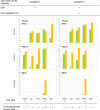Improved artificial intelligence discrimination of minor histological populations by supplementing with color-adjusted images
- PMID: 37925580
- PMCID: PMC10625567
- DOI: 10.1038/s41598-023-46472-7
Improved artificial intelligence discrimination of minor histological populations by supplementing with color-adjusted images
Abstract
Despite the dedicated research of artificial intelligence (AI) for pathological images, the construction of AI applicable to histopathological tissue subtypes, is limited by insufficient dataset collection owing to disease infrequency. Here, we present a solution involving the addition of supplemental tissue array (TA) images that are adjusted to the tonality of the main data using a cycle-consistent generative adversarial network (CycleGAN) to the training data for rare tissue types. F1 scores of rare tissue types that constitute < 1.2% of the training data were significantly increased by improving recall values after adding color-adjusted TA images constituting < 0.65% of total training patches. The detector also enabled the equivalent discrimination of clinical images from two distinct hospitals and the capability was more increased following color-correction of test data before AI identification (F1 score from 45.2 ± 27.1 to 77.1 ± 10.3, p < 0.01). These methods also classified intraoperative frozen sections, while excessive supplementation paradoxically decreased F1 scores. These results identify strategies for building an AI that preserves the imbalance between training data with large differences in actual disease frequencies, which is important for constructing AI for practical histopathological classification.
© 2023. The Author(s).
Conflict of interest statement
The authors declare no competing interests.
Figures







References
-
- Szczykutowicz TP, Toia GV, Dhanantwari A, Nett B. A review of deep learning CT reconstruction: Concepts, limitations, and promise in clinical practice. Curr. Radiol. Rep. 2022;10:101–115. doi: 10.1007/s40134-022-00399-5. - DOI
Publication types
MeSH terms
Substances
LinkOut - more resources
Full Text Sources
Medical

